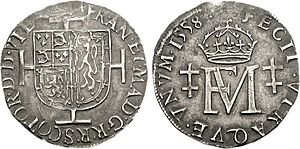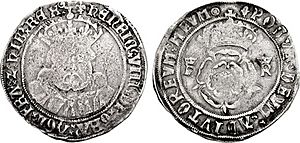Shilling (English coin) facts for kids
The English shilling was a silver coin used in the Kingdom of England. When it was first made, it was called a testoon. One shilling was worth twelve pence. Also, there were 20 shillings in one pound sterling. The English shilling started being used in the 1500s. It stayed in use until 1707. That year, England and Scotland joined to form the Kingdom of Great Britain. The English shilling then became the British shilling.
Contents
What's in a Name?
The word shilling comes from an old English word. That word was scilling. It meant "to separate." This word was used long ago, even in Anglo-Saxon times. It was a way to talk about money. A shilling was a twentieth part of a pound. But for a long time, there wasn't a coin specifically for that value.
Some people think the word came from the Norse language. But this is not true. The word "shilling" was in English laws many years before Norse people came to Britain. For example, it was in the Law of Æthelberht from Kent.
History of the English Shilling
The First Shilling: The Testoon
The testoon was the first coin like the shilling. It was introduced in England by King Henry VII. This happened around 1489. Very few of these coins were made. This shows they were not for everyday use. They were likely test coins or samples.
In Scotland, the testoon was also introduced. This happened during the reign of Mary, Queen of Scots. The first Scottish testoons were made in 1553. These early Scottish testoons are very rare today.
Henry VIII's Shillings (1509–1547)
More testoons were made later in Henry VIII's reign. Mints in London (Tower), Southwark, and Bristol made them. This was from 1544 to 1551. These testoons were made from silver that wasn't very pure. They are known as "base silver testoons."
Some of these coins were even made after Henry died in 1547. The Bristol coins often had "BRISTOLLIE" or "BRISTOLIE" on the back. The front of these coins showed Henry VIII's face. The back had a crowned rose.
Here are some of the special marks on these coins:
- TOWER (London)
- two lis (a type of lily symbol)
- lis
- pellet in annulet (a dot in a ring)
- Southwark
- S
- E
- Bristol
- WS (for William Sharington)
Edward VI's Shillings (1547–1553)
Edward VI, Henry VIII's young son, continued making these coins. During his reign, the coins were called "shillings" for the first time. These shillings showed the young king's face. Unlike his father's coins, Edward VI's shillings often had the date on them. The dates were written in Roman numerals.
These coins were made at several mints. These included Durham House, Tower, Southwark, Canterbury, and Bristol.
Here are some of the special marks and dates for these coins:
- Durham House 1548
- BOW (very rare)
- Durham House 1549
- BOW
- Tower 1549
- ARROW
- GRAPPLE
- PHEON
- SWAN
- Southwark 1549
- Y
- EY
- Canterbury 1549
- ROSE
- T
- Bristol 1549
- TC
- Tower 1550
- LION
- LIS
- PHEON AND SWAN
- MARLET
- CROWNED LEOPARD'S HEAD
- Southwark 1550
- Y
- LIS AND Y
- Tower 1551
- LION AND ROSE
- ROSE AND ROSE
- Southwark 1551
- Y AND LIS
- Undated issue (Durham House)
- BOW
Fine Silver Shillings
In 1551, the silver used for coins became much purer. It went back to the usual "sterling" silver (92.5% pure). These shillings show a striking image of the king. Many were made, but they are often found quite worn today.
Special marks for these coins:
- Tower or Southwark. No date (1551)
- Y
- Tower. No date (1551–3)
- TUN
Mary's Shillings (1553–1558)
No shillings were made in England until Queen Mary I of England married Philip of Spain in 1554. However, Irish shillings with Mary's picture were made before her marriage.
After Mary's marriage, some shillings were made. To make Philip more popular, his face was put on these coins. His face was shown opposite Mary's. These coins are quite rare. They often have Arabic dates. Some also have a value mark (I__II) above the royal shield. All these coins were made at the Tower mint.
Elizabeth I's Shillings (1558–1603)
One of the first things Elizabeth I did was to revalue the Edward VI shillings. They were given new marks to show their true worth. These coins have a portcullis (a gate symbol) or a greyhound mark. They are very rare. The portcullis mark meant the coin was worth four and a half pence. The greyhound mark meant it was worth two and a quarter pence.
Then, many new silver coins were made. The shilling was one of them. The date was removed from the design. But special mint-marks can still tell us the year. No shillings were made between 1562 and 1582. After that, many more were produced.
Special marks for these coins:
- Hammered issue (all made at the Tower mint)
- Lis (1559–1560)
- Cross crosslet (1560–61)
- Marlet (1560–61)
- Bell (1582–83)
- A (1582–84)
- Escallop (1584–86)
- Crescent (1587–89)
- Hand (1590–92)
- Tun (1592–95)
- Woolpack (1594–96)
- Key (1595–98)
- Anchor (1597–1600)
- 1 (1601)
- 2 (1602)
- Milled issue (Tower mint only)
- Star (1560–1)
The "milled issue" coins were made using machines. This was done by Eloye Mestrelle. These coins were successful, especially the sixpences. Shillings from this time are rarer than sixpences. They are often found in poor condition.
James I's Shillings (1603–1625)
During the reign of King James I, coins continued to be made similarly. These shillings had the value "XII" (for 12 pence) in front of the king's face. Some shillings also had a plume (feather) above the shield. This showed they were made from Welsh silver.
Special marks for these coins:
- First coinage (with the phrase Exurgat deus dissipentur inimici on the back)
- Lis (1603–4)
- Thistle (1603–4)
- Second coinage (with the phrase Quae deus coniunxit nemo seperat on the back, and a square beard on the king)
- Lis (1604–5)
- Rose (1604–6)
- Escallop (1606–7)
- Grapes (1607)
- Coronet (1607–9)
- Key (1609–10)
- Mullet (1611–2)
- Tower (1612–3)
- Trefoil (1613)
- Tun (1613–5)
- Cinquefoil (1613–5)
- Closed book (1615–6)
- Plain cross (1617–18)
- Third coinage (with very long, curly hair on the king)
- Spur Rowel (1619–20)
- Rose (1620–1)
- Thistle (1621–3)
- Lis (1623–4)
- Trefoil (1624)
- Welsh issues (with a plume above the shield)
- Thistle (1621–3)
- Lis (1623–4)
- Trefoil (1624)
From 1625 to 1706
Shillings continued to be made in every reign after James I. They were also made during the time of the Commonwealth.
In 1707, England and Scotland joined together. They formed the Kingdom of Great Britain. Because of this, the English shilling became the British shilling.
See also



